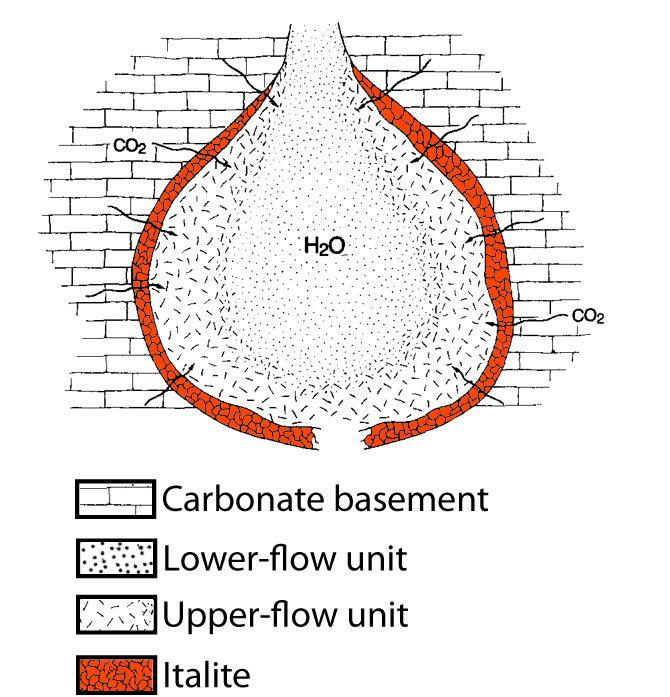Italite
Italite: Rock consisting almost entirely of leucite held together by small amounts of glass. Now defined modally as a leucocratic variety of foidolite in which the foid is predominantly leucite. (Washington, 1920, Alban Hills, near Rome, Italy).Italite was originally described by Washington (1920), for an occurrence in Villa Senni (Alban Hills), in Italy, hence the name. The type locality where italite was discovered by the Italian geogolgit Gian Alberto Blanc (University of Rome) is about 14 km southeast of Rome, north of the Agnanina road to Grotta Ferrata. The quarry is alongside the Rome Frascati railway, about one half of one km northeast Of Villa Senni. From 1903 to 1909, leucite and leucite rock at Villa Senni, were extracted for use as a potash fertilizer.
Washington reports that: "The Villa Senni quarry consists, in the main, of fragments of the usual lavas of the Alban Volcano, with scoriaceous lapilli, both of these ranging in from that of a hazel nut to that of an egg, or larger. There is also considerable fine volcanic ash and dust. In this agglomerate are blocks, up to a foot or more in length. They are coarse-grained and of plutonic habit. Most of them are leucitic, varying from the almost purely leucitic italite, through augite-Ieucite rocks (missourite), to pyroxenite with subordinate or no leucite. Biotite is usually present, and some of the blocks consist almost wholly of this mineral".
In his original work, Washington (1920; 1927) describes the italite as: "Typical italite is very pale yellowish, which slight weathering renders duller and grayer. Some of the specimens are rather friable, but the best are very firm. The rock is coarsely granular, made up almost wholly of rounded, anhedral, equant leucite crystals, from 5 to 10 mm. in diameter. The barely yellowish leucite crystals are with vitreous luster, and they are free from inclusions except for very rare and minute of black augite. Between the leucite crystals there occurs in places a very thin film of a dull white substance, which is most abundant in the slightly weathered specimens. The best and firmest specimens, such as that which was analyzed, being practically free from this. In thin section the texture is seen to be granitoid, in the sense that the rock is holocrystalline, coarse-grained, and aphyric, and that all the leucite individuals are anhedral and closely appressed".
The Villa Senni Eruption
The Villa Senni Eruption Unit (VSEU) belongs to the Tuscolano-Artemisio phase of volcanic activity in the Alban Hills Volcanic District, the closest to Rome of the recent or active volcanoes of central Italy. The Villa Senni Eruption Unit represents the last large explosive event of the Tuscolano-Artemisio phase. The VSEU products are known in the literature as "tufo lionato", "pozzolanelle" and "tufo di Villa Senni". Field relationships suggest that no significant time interval separates these deposits.
The most important products of this eruption are represented, from bottom to top as:
(1) ash-grained, cross-laminated pyroclastic surge deposits, typically showing marks of uncharred vegetation, with a maximum thickness of 15 cm.
(2) up to 75 cm thick, reversely graded Scotia fall deposits.
(3) lower pyroclastic flow unit.
(4) upper pyroclastic flow unit.
(5) discontinuously exposed, accretionary lapilli-bearing, fine ash layers, passing upward to paleosol.
Three main rock types form Villa Senni Eruption Unit: (1) juvenile K-foiditic scoria clasts of the lower-flow unit; (2) juvenile phonotephritic scoria clasts of the upper-flow unit; and (3) holocrystalline phonotephritic lithic inclusions (Italites) in the upper-flow unit. The Italites lithic inclusions represent holocrystalline granular allotriomorphic rock type, made up of predominant millimeter-sized crystals of leucite and clinopyroxene, in variable proportions, dark mica (up to 17 vol.%), brown garnet (up to 5%), usually enclosed in the clinopyroxene, apatite (up to 1%), enclosed in clinopyroxene and garnet, rare Fe-Ti oxides. The sequence of crystallization was apatite, garnet, clinopyroxene, leucite, dark mica; the final crystallization of dark mica was accompanied by resorption of garnet. The petrographic and geochemical characteristics indicate that lower-flow unit, upper-flow unit, and Italites rock types are linked by a crystal fractionation process. The most differentiated rock type, represented by lower-flow unit, might be obtained from a parental melt of upper-flow unit composition by a CO2-controlled crystal-liquid fractionation of a solid assemblage close in composition to that of italites.
The storage of magma (Fig.1) occurred at shallow depth within the Mesozoic carbonate country rocks, where, CO2 diffusion, originating from thermal decomposition of wall-rock carbonates, controlled the evolution trend of the melt at the periphery of the magma chamber, whereas the inner part of the magma body retained the volatile component (essentially H2O) of the original melt.
The corresponding eruption model is therefore comprehensive of an early eruptive phase (lower-flow unit rock type) involving the more differentiated central magma bulb, whereas the late eruptive phase (upper-flow unit rock type) tapped the more mafic peripheral magma. The italite xenoliths are believed to represent the chilled margins of the magma chamber.

Fig.1: Sketch of the pre-eruptive magmatic reservoir of Villa Senni volcanic center; Italites in red. Modified after Freda (1997).
.jpg)
Fig.2:Italite sample, Alban Hills.
Sample kindly given to me by F.Stoppa
Bibliography
• Washington, H. S. (1920). Italite, a new leucite rock. American Journal of Science, (295), 33-47.
• Washington, H. S. (1927). The italite locality of Villa Senni. American Journal of Science, (81), 173-198.
• Freda, C., Gaeta, M., Palladino, D. M., & Trigila, R. (1997). The Villa Senni Eruption (Alban Hills, central Italy): the role of H 2 O and CO 2 on the magma chamber evolution and on the eruptive scenario. Journal of Volcanology and Geothermal Research, 78(1), 103-120.


.jpg)
.jpg)
.jpg)
.jpg)
.jpg)
.jpg)
.jpg)
.jpg)
.jpg)
.jpg)
.jpg)
.jpg)
.jpg)
.jpg)
.jpg)
.jpg)
.jpg)
.jpg)
.jpg)
.jpg)
.jpg)
.jpg)
.jpg)
.jpg)